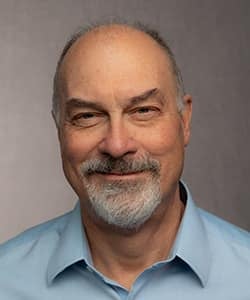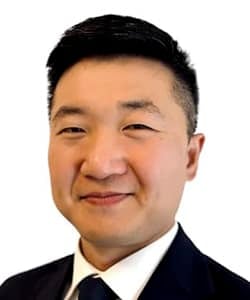Interview with the 2025 John J. Bonica Award Winner: Dr. Marc Huntoon
Cite as: Meng H. Interview with the 2025 John J. Bonica Award Winner: Dr. Marc Huntoon. ASRA Pain Medicine News 2025;50. https://doi.org/10.52211/asra110125.007.

Howard Meng: What inspired you to pursue a specialty practice in pain medicine?
Marc Huntoon: The length of the core anesthesiology residency had recently changed, and I completed a mini-fellowship in my third year (6 months obstetric anesthesia track at Wake Forest) as well as 6 months of pain management at Portsmouth Naval Medical Center. The leadership in anesthesiology at the time for Portsmouth Naval (Captain Rob Carnes and Captain Bill Little) felt like the time was right to start a pain medicine fellowship in the military and asked me to be the first. I was really drawn to the pain-relieving aspects of obstetric, acute and chronic pain and there was a huge need for expertise in those areas. I was good with procedures and had picked up some research experience from working with Jim Eisenach (who better?) at Wake Forest, so my future aspirations just seemed to flow from that.
HM: Can you share a pivotal moment from your time in the military that influenced your approach to patient care?
MH: There are so many, but I really think of my first day as an anesthesia resident. I did a blood patch (my first ever epidural!) on an unfortunate young woman, who had just delivered a few days before, and later a trans-arterial axillary brachial plexus block, both of which were messy, complicated, and embarrassing. I swore to myself that day that I would not only master those techniques but make them more elegant and never have complications again!
HM: After holding leadership positions at major institutions in the United States, what aspects of academic medicine do you find most rewarding?
MH: Two things: First, the trainees are always important to me as there are far too many examples of poor training still prevalent. It’s important to me that the folks I train become excellent at what they do and do it with integrity. Second, I appreciated the chance to explore ways to improve patient care by examining the current status quo and developing innovative solutions to address the problem. Some have called me a “cowboy,” but better to try and fail than to hold on to dead therapies.
Many times on a journey, we can’t really see where we’re going without the guidance of a mentor. Life choices should be guided by self-actualization rather than external forces.
HM: What has been your biggest takeaway as the editor in chief for RAPM?
MH: One of the things I was most proud of and fulfilled by was this role. It’s very hard, and you basically don’t get a vacation for the period you sign up for. But, to use a cliché, “you’re the man ( or woman).” You set the editorial vision, goals, content, and conduct. I felt that letting writers get their opinions out there was important, regardless of many criticisms.
HM: As the former editor in chief for RAPM, how do you view the role of medical publishing in advancing pain management?
MH: This is our greatest challenge. I always liked to confront dogma and foment change. I started a section in the RAPM journal called “Daring Discourse” for that reason and have been happy that the current editor in chief Brian Sites has continued it. Critically, I think it has been a hit and miss at times, but such is science. When I think about all the mistakes that were made during the COVID years, for example, the stakes are very high. We must strive for equipoise in our approach to trial populations and overcome our reliance on conforming to artificial societal/personal agendas and overcome our biases. Editors have to exercise good stewardship to truly advance the field.
HM: What traits do you believe are most important for young physicians entering the field of pain medicine?
MH: I’m troubled by the statistics that less and less of our residents are opting for pain fellowships. Unfortunately, I believe that economics, opioids, and payor policies have all played a role. I still think that the best fellows are those who enjoy anatomy, neuroscience, and medical interventions, and can effectively combine their skills/knowledge with empathy and understanding.
HM: Can you share your approach to mentoring medical students and residents interested in pain medicine?
MH: Similar to the last question, I illustrate to trainees what their pathway is/should be. Many times on a journey, we can’t really see where we’re going without the guidance of a mentor. Life choices should be guided by self-actualization rather than external forces.
HM: You hold patents for pain-relieving devices. What is the process like, and how do you see technology transforming pain care?
MH: I really think that with AI, robotics, etc., we are moving towards the potential for hybridization. It’s funny, but I actually believed that some of my ideas would improve outcomes for patients. Perhaps they have, in the sense that peripheral nerve stimulation as a pain treatment has emerged from the dead over the last decade. There are simply so many barriers! I recall one of my devices almost reaching the prototype production phase with a large startup fund, but it stalled because there wasn’t a current procedural code that it fit into. Who would have thought that a great way to help patients would not be adopted because we couldn’t code for it with our current antiquated payment model!
HM: Given your experience in neuromodulation, how do you think the field of neuromodulation will evolve over the next decade?
MH: Unfortunately, the rubber has met the road. Despite all that I said previously, it’s really going to depend on two things: 1. someone somehow doing better studies that the larger scientific community (not just the believers) can embrace; and 2. the ability of society to pay for it.
HM: What has been the most significant change you’ve observed in patient expectations or demographics in pain medicine over your career?
MH: Unfortunately, there’s an expectation that “the pain specialists” will prescribe all the meds and an absolute entitlement by some patients to that course of therapy. There is a special place in the afterlife for those who got us on this course.
HM: What personal or professional accomplishment are you most proud of in your career?
MH: I never sought out numerical goals for publications or awards, for example. Plenty of good researchers produced three to four times what I did. Two things I did were: 1. to understand and eliminate some types of complications; and 2. to establish peripheral nerve stimulation as a viable and growing pain control modality that can be minimally invasive and successful.
HM: How do you continue to challenge yourself and pursue lifelong learning in such a rapidly evolving specialty?
MH: Being a medical affairs leader in the industry has allowed me to stay in contact with the things I enjoy. However, I have begun to ponder more existential questions and have come to appreciate farming and grandfathering.
HM: What advice would you give to those navigating the intersection between research, clinical practice, and education?
MH: Stay on your path, overcoming all the obstacles with a positive attitude.
HM: What is the next challenge you have your sights set on?
MH: Becoming a better farmer!
